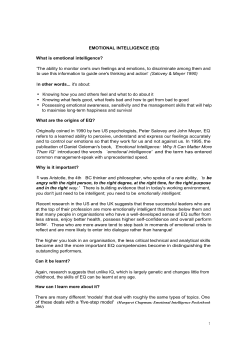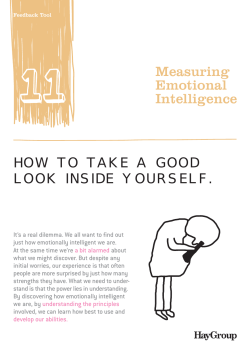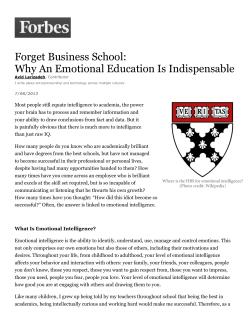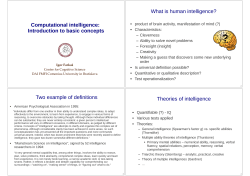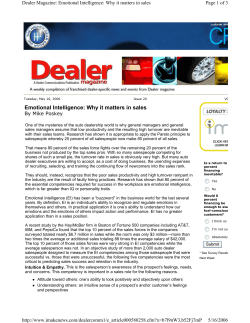
Cultural Intelligence Why Every Leader Needs It
Cultural Intelligence Why Every Leader Needs It By David Livermore, Linn VanDyne, and Soon Ang For many business leaders, cultural awareness and understanding is considered a soft skill that can be taken lightly compared to hard skills like market research, negotiation strategies, and business development November 2011 acumen. But a leader’s ability to successfully do any of these tasks in a multicultural context quickly becomes a bottom-line issue when dealing with real people in real situations. Thankfully, there’s an emerging body of research that provides tangible ways to assess and develop cultural The predominant approach to cultural competence was teaching people about specific cultures and assuming that “head” knowledge would translate into sensitivity and effectiveness in intercultural contexts. intelligence, or CQ—the capability to function effectively across various cultural contexts. Cultural intelligence is rooted in more than a decade of rigorous academic research across dozens of different cultures. It’s led to a whole new way of approaching cross-border management, diversity training, and virtual team development. Previously, the predominant approach to cultural competence was teaching people about specific cultures and assuming that “head” knowledge would translate into sensitivity and effectiveness in intercultural contexts. In contrast, our findings indicate that a leader’s cultural intelligence is largely a personal capability rooted in the individual’s internal motivation, thinking, consciousness, and adaptability. Evidence-based research demonstrates that CQ is a capability that can be assessed and developed with promising results for those who manage with cultural intelligence. We begin by reviewing the four capabilities of cultural intelligence and then we describe ways leaders can assess and develop this CQ capability in themselves and others. FOUR CAPABILITIES OF 1. CQ Drive: Showing interest, and employees headed out on CULTURALLY INTELLIGENT confidence, and drive to adapt international assignments are cross-culturally often more concerned about CQ Drive is the leader’s level of moving their families overseas and interest, motivation, and getting settled than they are about confidence to adapt cross- developing cultural culturally. This refers to whether understanding. Without ample or not you have the confidence motivation, there’s little point in and drive to work through the spending time and money on challenges and conflict that often training. LEADERS Leaders with high CQ can effectively adapt their leadership style to fit multicultural situations involving customers, suppliers, and associates from diverse backgrounds. Leaders with high CQ demonstrate strength in four distinct CQ capabilities (CQ Drive, Knowledge, Strategy, and Action). All four capabilities are needed because focusing on one without the others may actually result in increased cultural ignorance rather than enhanced cultural intelligence. This is because CQ requires an overall repertoire of adaptive capabilities. The four CQ capabilities are: accompany intercultural work. The ability to be personally engaged and to persevere through intercultural challenges is one of the most novel aspects of cultural intelligence. Many intercultural training approaches simply assume that people are motivated to gain cross-cultural capabilities. Yet employees often approach diversity training apathetically, Doug, a North American with a multinational firm who was sent to manage a team in Bangkok describes how little he paid attention to the cultural training he received before moving to Thailand. It wasn’t that he didn’t care. It’s just that he was overwhelmed getting ready for the move and he found the training The Four Capabilities of Culturally Intelligent Leaders 2 overly theoretical and too focused quickly discovered that leading upon cultural stereotypes. But he and motivating his mostly Asian definitely wanted to succeed. team wasn’t coming easily. He had CQ Drive includes intrinsic motivation—the degree to which you derive enjoyment from culturally diverse situations, extrinsic motivation—the more tangible benefits you gain from culturally diverse experiences, and a longstanding reputation for being a phenomenal negotiator. But his negotiations here kept getting stalled. Even though he had extensive management experience, he was losing confidence in his ability to be a good leader. self-efficacy— your confidence One of the most important parts of that you will be effective in an CQ Knowledge is a macro intercultural encounter. All three understanding of cultural systems of these motivational dynamics and the cultural norms and values play a role in how leaders associated with different societies. approach multi-cultural situations. In order to lead effectively you Stop and examine your motivation need to understand ways that for doing cross-cultural work. communication styles, Your CQ Drive is strongly related predominant religious beliefs, role to your effectiveness in new expectations for men and women cultural contexts. etc. can differ across cultures. In 2. CQ Knowledge: Understanding intercultural issues and differences CQ Knowledge is the cognitive dimension of cultural intelligence. It refers to the leader’s level of understanding about culture and culture’s role in shaping the way to do business when different cultures are involved. Your CQ Knowledge is based upon the degree to which you understand ! Intrinsic ! Extrinsic ! Self Efficacy addition, general knowledge about different types of economic, business, legal, and political systems that exist throughout the world is important. And you need a core understanding of culture, language patterns and nonverbal behaviors. This kind of knowledge helps build your confidence when working in a new cultural environment. the idea of culture and how it The other important part of CQ influences the way you think and Knowledge is understanding how behave. It also includes your culture influences your overall understanding of the ways effectiveness in specific domains. cultures vary from one context to For example, being an effective the next. global leader in business looks When Doug got to Bangkok, he CQ DRIVE different from being an effective 3 leader of a multicultural about our own thought processes university. And working across and draw upon our cultural borders for an information knowledge to understand a technology company requires a different cultural context and solve CQ KNOWLEDGE different application of cultural problems in that situation. It understanding than working includes whether we can use our ! Culture General ! Culture Specific across borders for a charitable cultural knowledge to plan an organization or on a military appropriate strategy, accurately initiative. This kind of specialized, interpret what’s going on in an domain-specific cultural intercultural situation, and check knowledge combined with a macro to see if our expectations are understanding of cultural issues is accurate or need to be adjusted. a crucial part of leading with cultural intelligence. individuals to pursue their most often emphasized in typical personal goals and to “lead approaches to intercultural themselves”. He was aware that competency. A large and growing this was a countercultural training and consulting industry approach in Asia. But he had no focuses on teaching leaders about interest in becoming a highly general cultural values. While directive leader. So he had to valuable, however, the knowledge develop a strategy for how to be that comes from CQ Knowledge true to himself while effectively has to be combined with the other leading a team with values three capabilities of CQ or its different from his. leadership is questionable and potentially detrimental. ! Planning ! Awareness ! Checking style focused upon developing CQ Knowledge is the area that is relevance to the real demands of CQ STRATEGY Doug has always used a leadership Seasoned leaders often jump into meetings and new situations with little planning. This often works 3. CQ Strategy: Making sense of fine when meeting with colleagues culturally diverse experiences and or clients from a similar cultural planning accordingly background. By drawing upon CQ Strategy refers to the leader’s emotional intelligence and level of awareness and ability to leadership experience, we can strategize when crossing cultures. often get away with “winging it” This capability involves slowing because we know how to respond down the rpm’s long enough to to cues and how to talk about carefully observe what’s going on various projects. When meetings inside our own and other people’s heads. It’s the ability to think involve individuals from different most important aspects of CQ cultural contexts, however, many Action is knowing when to adapt of the rules change. Relying upon to another culture and when not to our ability to intuitively respond to do so. A leader with high CQ cues in these more novel situations learns which actions will and is dangerous. That’s where CQ won’t enhance effectiveness and Strategy comes in. acts upon that understanding. CQ Strategy includes planning, awareness, and checking. Awareness means being in tune Thus, CQ Action involves flexible behaviors tailored to the specific cultural context. with what’s going on in one’s self Doug is grateful for a team of staff and others. Planning is taking the who are fluent in English. He’s time to prepare for an intercultural learning some basic Thai to get encounter – anticipating how to along. But at times, he feels like he approach the people, topic, and has to relearn English too. His situation. Checking is the assistant needs very explicit, step- monitoring we do as we engage in by-step directions. And on the rare interactions to see if the plans and occasion when she makes a request expectations we had were of him, he has the hardest time appropriate. It’s comparing what figuring out exactly what she’s we expected with our actual asking for. experience. CQ Strategy emphasizes implementation. It’s the lynchpin between understanding cultural issues and actually being able to use that understanding to manage effectively. CQ Action includes appropriate flexibility in speech acts – the exact words and phrases we use when we communicate specific types of messages (e.g. offering negative feedback directly or indirectly or knowing how to appropriately 4. CQ Action: Changing verbal make a request). It also includes and nonverbal actions the capability to be flexible in appropriately when interacting verbal and nonverbal actions. cross-culturally While the demands of today’s Finally, CQ Action is the leader’s intercultural settings make it ability to act appropriately in a impossible to master all the dos wide range of cultural situations. It and don’ts of various cultures, influences whether we can actually there are certain behaviors that accomplish our performance goals should be modified when we effectively in light of different interact with different cultures. CQ ACTION ! Speech Acts ! Verbal ! Nonverbal cultural situations. One of the 5 For example, Westerners need to area is strongest and weakest for learn the importance of carefully you. studying business cards presented by those from most Asian contexts. Also, some basic verbal and nonverbal behaviors enhance the extent to which we are seen as effective by others. As an example, the verbal tone (e.g., loud vs. soft) in which words are spoken can convey different meanings across cultures. And although it is not Leading with Cultural Intelligence 1. Reflect on your own CQ capabilities 2. Assess and Develop the CQ of Others 3. Assess the crossborder effectiveness of the organization as a whole 4. Integrate global effectiveness into the strategic plan. necessary for an outsider to master the intricacies of bowing in Japan, appropriate use of touch is something to bear in mind. In sum, almost every approach to intercultural work has insisted on CQ Drive: What’s my level of interest in cross-cultural issues? CQ Knowledge: To what degree do I understand how cultures are similar and different? CQ Strategy: Am I aware of what’s occurring in a crosscultural situation and am I able to plan accordingly? CQ Action: Do I know when I should adapt and when I should not adapt my behavior crossculturally? the importance of flexibility. With Each of us is stronger in some of CQ Action, we now have a way to these areas than others. Zero in on enhance flexibility. one specific CQ capability to begin LEADING WITH CULTURAL increasing your overall CQ. INTELLIGENCE There are a variety of academically In order for cultural intelligence to validated CQ assessments that are impact the bottom line, leaders proven to predict the degree to need to think strategically about a which you are able to adjust and long-term approach for perform in intercultural contexts. developing this capability. A few of The CQ Self-Assessment is a great the key strategies for leading with way to begin developing awareness cultural intelligence include the by reflecting on your intercultural following: abilities. As a next step, the CQ 1. Reflect on your own CQ Capabilities Begin with a commitment to consider your own capabilities for leading across cultures. By thinking through the four capabilities of CQ, consider which Multi-Rater Assessment can be used as a 360-degree instrument that allows bosses, peers, direct reports, clients, and sometimes even family members to assess you according to the four CQ capabilities and the subdimensions of each. Find more 6 information about these and other 3. Assess the cross-border CQ assessments at effectiveness of the organization www.culturalQ.com as a whole. 2. Assess and Develop the CQ of Others Next, utilize the above ideas with your colleagues and with those you manage. Begin by assessing the CQ of strategic leaders and associates who have the most interaction Cultural intelligence begins at the personal level. But leading with cultural intelligence must also include an analysis of the organization’s practices. Some questions to begin with are: • What’s our level of success with culturally diverse contexts. working internationally Next, add CQ assessment and and/or across different ethnic feedback to ongoing HR programs cultures domestically? for large numbers of employees. • from personnel and Don’t put everyone through the clients/constituents who come same one-size fits all intercultural from different cultural training plan. Some have plenty of knowledge but not a lot of motivation. Others are very backgrounds? • behavior. Empower your team and strategic decisions? • also adapting to various personalized CQ development cultures? plans based upon their CQ Bringing in speakers, offering workshops, and distributing books to offer a common language and vision can be very helpful within this context. Just be sure the education and training fits within a larger plan. And whenever possible, provide personnel with individualized feedback and coaching to help them in this What’s our plan for retaining our core identity/brand while your colleagues to develop strengths and weaknesses. To what degree do cultural differences inform our motivated but aren’t quite sure how to translate that into effective What’s the level of satisfaction 4. Integrate global effectiveness into the Strategic Plan Rather than simply relegating cross-border effectiveness to the “international sales” division or to the “diversity and inclusion officer”, make it part of the overall strategic plan for the organization. • How does culture inform the way R&D do their work? process. 7 • How does a globally dispersed workforce and/or clientele need to shape the way I.S. develops their processes? • How will the targets identified at the C-suite level be informed by cross-border issues? The demands of leading in an era of escalating globalization are fast and furious. Companies need leaders who have the know-how to quickly adjust to dozens of different cultures on a daily basis. Research proves that this is a capability that can be developed by any manager. But it takes more than just a gut-level, sixth sense that is often promoted in leadership circles. It requires discipline and hard work as well as adaptability for leaders to inspire, innovate, and negotiate effectively in today’s increasingly diverse world. And with that hard work, slowly but surely, managers and companies can expect to see the bottom line implications of leading with cultural intelligence. David Livermore, Ph.D. has written several books on global leadership and cultural intelligence including Leading with Cultural Intelligence For more information on cultural intelligence, visit www.culturalQ.com David Livermore, Ph.D. has written several books on global leadership and cultural intelligence including Leading with Cultural Intelligence and his newest release, The Cultural Intelligence Difference. He’s president of the Cultural Intelligence Center in East Lansing, MI and has worked with leaders in more than 100 countries. www.davidlivermore.com Linn Van Dyne, Ph.D. is a professor management at Michigan State University, where she does research on discretionary behavior and cultural intelligence, serves on five editorial boards, and is Associate Editor of Organizational Behavior and Human Decision Processes. She co-edited The Handbook of Cultural Intelligence. Prior to her academic career, she held management positions in for-profit and not-forprofit organizations, including leading the Human Resources Group for a multinational manufacturing firm with locations all over the world. www.linnvandyne.com Soon Ang, Ph.D is the Goh Tjoei Kok Distinguished Chair and Professor in Management at the Nanyang Technological University in Singapore. She is a recognized world authority in Cultural Intelligence (CQ), global leadership, and outsourcing. She pioneered and coauthored two foundation books on CQ and co-edited the Handbook of Cultural Intelligence (ME Sharpe). Her ideas on CQ have been described as the most cogent, well researched, and comprehensive. www.soonang.com 8
© Copyright 2025
